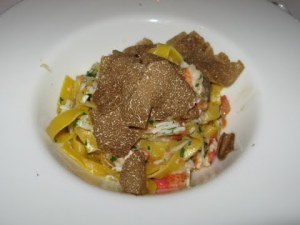The day: 6 November 2009, Dinner.
The place: 13 Albemarle Street, LondonW1S 4HJ
The venue: Dolada
The food: Modern Italian
The drinks: Supple, strong on Italians
NOTE: THIS RESTAURANT IS NO MORE
We had meant to try Dolada for a while, as recommendations came to us from more than one quarter. Well, as often happens, high expectations led to bitter (literally: read on) disappointment. We just did not see the point of this place, formerly known as Mosaico (endearingly this name was still printed on the bill we received) and we are going to tell you why.
We begin well, the tables very comfortable, the room very inviting, warm (red wood) and pleasant, except for the people, including over-wealthy youth and boorish business apes.
A very promising amuse is brought to us by a waiter who, in the vain attempt to describe it, mutters some incomprehensible words. It is obvious he hasn’t the faintest idea what it it is, except that it definitely looks like an egg ‘a la coque’. Anyway, fittingly enough the amuse is amusing, the inside being a ‘scrambled egg white’ onion jam. It is airy, it is tasty, it is fun, it is velvety and luscious.
We like chefs who make a statement with their amuse, and Riccardo dal Pra, starred in Italy with a restaurant by the same name, definitely wants you to know what type of cuisine he stands for.
Expectations are set even higher.
And then everything comes down with a crashing flop.
Maybe we should have gone for the tasting menu, which includes the famous pizza glu-glu, the trademark drinkable pizza in which the basic components, mozzarella, basil and tomato are liquefied and separated and therefore drunk from a special bottle. Maybe we should have left Dal Pra fully express his jocular vein.
But we didn’t. And the rest of the dinner was not bad, but entirely forgettable. For example:
Tagliatelle with crab and truffle (£22)
The tagliatelle are well-made in terms of texture though rather too thick and heavy. No class. The flavours overlap rather than marry. Compared with the wonderful truffles we are used to (black and white), for example, at Latium, and the crab we can buy superfresh just 100 yards of where we live (no, not London) the performance is barely OK, rather a waste of the noble materials; and look at the price: we want to part from our hard-earned cash for the sake of taste, not the name of the ingredient.
And this:
Cuttlefish salad (£12)
The dish is pretty and looks humourous and, more importantly, like a good idea (the green sauce you see on the bottom is broccoli). But it turns out to be no more. The flavours are far from the promise of the looks. The tomato is sad, and the dish is in fact insipid. And the cuttlefish is even a little overcooked.
We were hoping with our:
Fish soup (£18)
Pretty, once again, but oh how lame! With all those materials inside, how could he achieve such a lack of deep flavours, of concentration? But the worst is still to come…
After a non-stop disappointment with starter, pasta and two mains we are in no mood for dessert, although we are kindly treated to the fun ‘petit four’, which are impressive enough.
The service
There is a service issue here, in that the waiters lower down the scale from the manager and the senior one do not seem to understand what they are serving. Also, the active request of whether you want to have pepper added to your dish is more fitting of a pizzeria than of a restaurant of this level, and is perhaps telling of the clientele they expect.
The low: Pan-fried cod with Sicilian cous cous (£18)
If so far the rest of the food had been just substandard for the hype and the price, this cod is really disastrous. The texture is dry and cardboardish, the taste is bitter (the skin). And the whole dish looks maladjusted, not standing together: just the two main materials juxtaposed to each other, with traces of (burned, as you can see) vegetables and thin liquid. What kind of a dish is this in a fine dining restaurant?
The high
There was the beginning, the amuse of ‘egg a la coque’, and no more. If we were intellectuals we could quote the opening from one of T.S. Eliot’s quartets, ‘In my beginning is my end…’*
The price
Expect £150 for a three course meal for two with a lower end wine, tasting menu at £55.
Conclusion
Never judge a restaurant from a single visit, they say. Maybe we found a bad night. But we cannot forget or forgive that Chef Dal Pra was right there, not in his starred Italian venue, and he allowed those bland (and on one occasion poor) dishes to go through the pass – did he not see the burnt veggies, for example? Our impression was one of somebody much concerned about show, fun and appearance (in the tasting menu) but not focussed on delivery in terms of detail and big flavours, at least in the regular dishes. Sorry, given the bloated prices, for us this is it: we won’t be back.
* Which ominously continues (slightly adapted for the occasion):
…In succession
Restaurants rise and fall, crumble, are extended,
Are removed, destroyed, restored, or in their place
Is an open field, or a factory, or a by-pass…
A new restaurant now stands
in Albemarle, too, where Giardinetto used to be.

























